Individual Knowledge Test for BSBWHS501: Workshop Assessment 1
VerifiedAdded on 2021/01/01
|14
|4512
|175
Homework Assignment
AI Summary
This document presents the answers to a knowledge test for the BSBWHS501 unit, which focuses on ensuring a safe workplace. The assessment covers key aspects of Work Health and Safety (WHS) legislation, including the roles of WHS authorities across Australia, the responsibilities of business owners, and the purpose of WHS legislation. It explores regulations, the Code of Practice, and legal requirements concerning employee mental health. The test also addresses worker consultation in policy development, and the areas covered by a health and safety management system. The provided answers reflect an understanding of the WHS Act, its implications, and the practical application of safety measures in various workplace scenarios, offering a comprehensive overview of workplace health and safety principles.
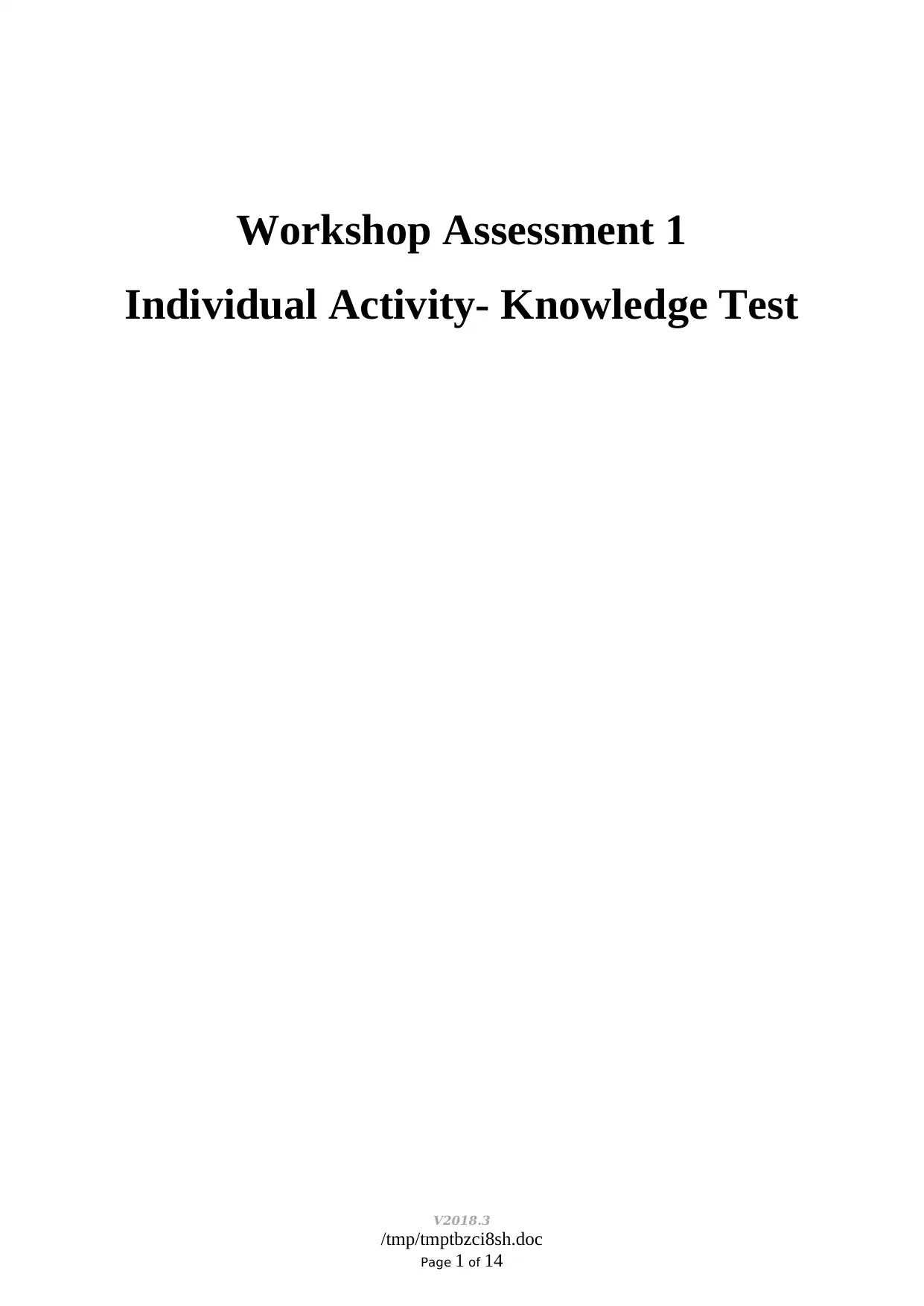
Workshop Assessment 1
Individual Activity- Knowledge Test
V2018.3
/tmp/tmptbzci8sh.doc
Page 1 of 14
Individual Activity- Knowledge Test
V2018.3
/tmp/tmptbzci8sh.doc
Page 1 of 14
Paraphrase This Document
Need a fresh take? Get an instant paraphrase of this document with our AI Paraphraser
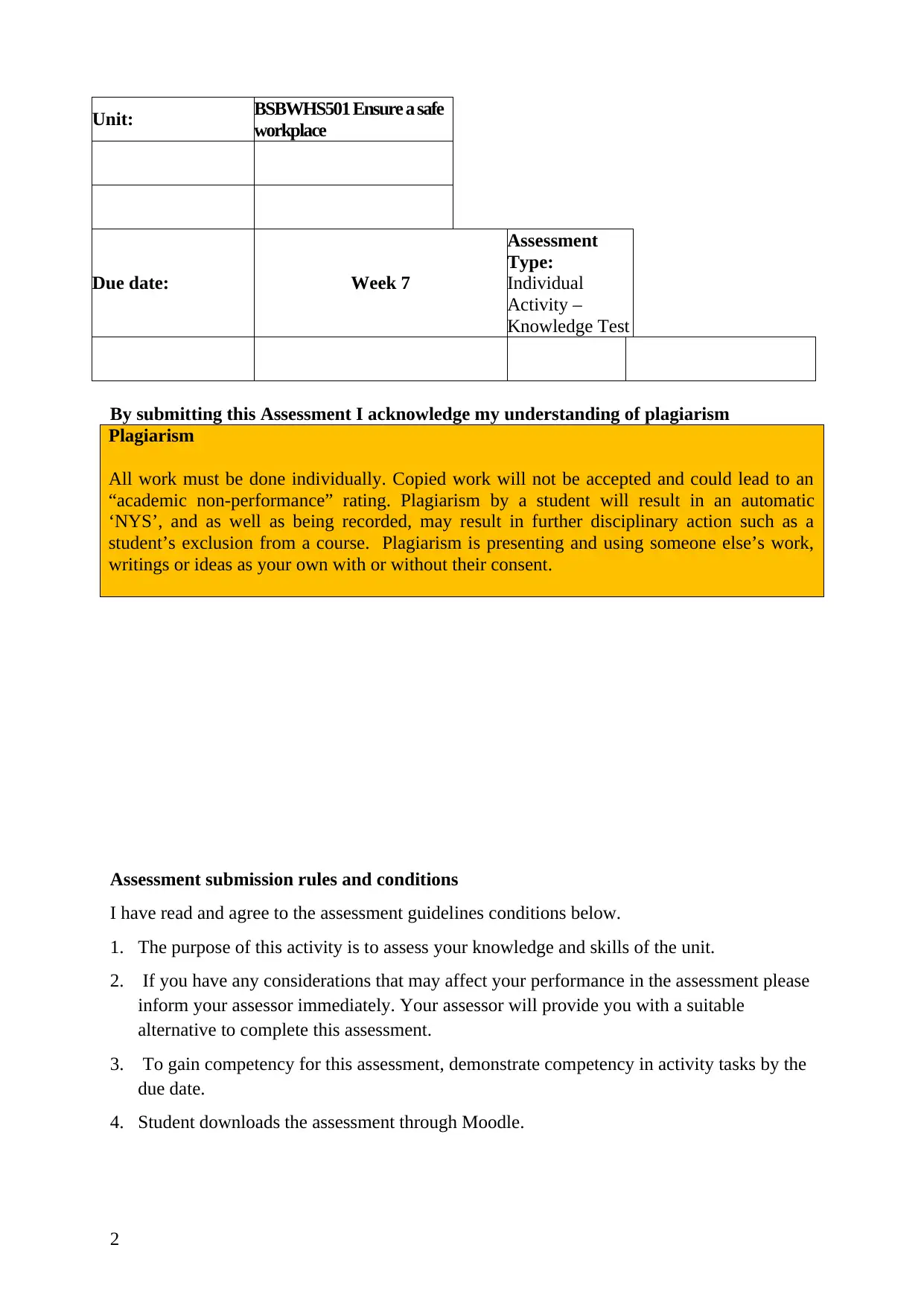
Unit: BSBWHS501 Ensure a safe
workplace
Due date: Week 7
Assessment
Type:
Individual
Activity –
Knowledge Test
By submitting this Assessment I acknowledge my understanding of plagiarism
Plagiarism
All work must be done individually. Copied work will not be accepted and could lead to an
“academic non-performance” rating. Plagiarism by a student will result in an automatic
‘NYS’, and as well as being recorded, may result in further disciplinary action such as a
student’s exclusion from a course. Plagiarism is presenting and using someone else’s work,
writings or ideas as your own with or without their consent.
Assessment submission rules and conditions
I have read and agree to the assessment guidelines conditions below.
1. The purpose of this activity is to assess your knowledge and skills of the unit.
2. If you have any considerations that may affect your performance in the assessment please
inform your assessor immediately. Your assessor will provide you with a suitable
alternative to complete this assessment.
3. To gain competency for this assessment, demonstrate competency in activity tasks by the
due date.
4. Student downloads the assessment through Moodle.
2
workplace
Due date: Week 7
Assessment
Type:
Individual
Activity –
Knowledge Test
By submitting this Assessment I acknowledge my understanding of plagiarism
Plagiarism
All work must be done individually. Copied work will not be accepted and could lead to an
“academic non-performance” rating. Plagiarism by a student will result in an automatic
‘NYS’, and as well as being recorded, may result in further disciplinary action such as a
student’s exclusion from a course. Plagiarism is presenting and using someone else’s work,
writings or ideas as your own with or without their consent.
Assessment submission rules and conditions
I have read and agree to the assessment guidelines conditions below.
1. The purpose of this activity is to assess your knowledge and skills of the unit.
2. If you have any considerations that may affect your performance in the assessment please
inform your assessor immediately. Your assessor will provide you with a suitable
alternative to complete this assessment.
3. To gain competency for this assessment, demonstrate competency in activity tasks by the
due date.
4. Student downloads the assessment through Moodle.
2
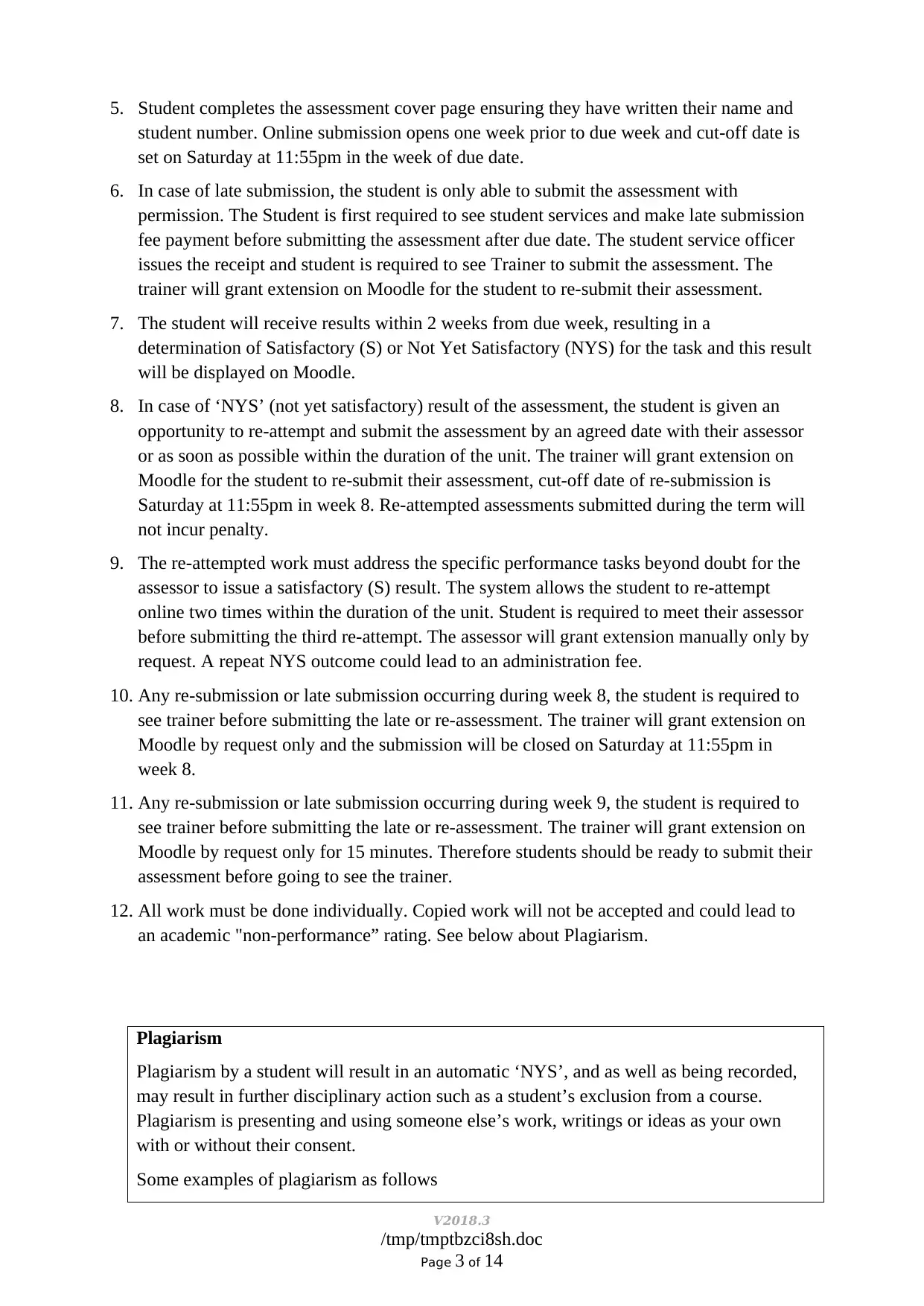
5. Student completes the assessment cover page ensuring they have written their name and
student number. Online submission opens one week prior to due week and cut-off date is
set on Saturday at 11:55pm in the week of due date.
6. In case of late submission, the student is only able to submit the assessment with
permission. The Student is first required to see student services and make late submission
fee payment before submitting the assessment after due date. The student service officer
issues the receipt and student is required to see Trainer to submit the assessment. The
trainer will grant extension on Moodle for the student to re-submit their assessment.
7. The student will receive results within 2 weeks from due week, resulting in a
determination of Satisfactory (S) or Not Yet Satisfactory (NYS) for the task and this result
will be displayed on Moodle.
8. In case of ‘NYS’ (not yet satisfactory) result of the assessment, the student is given an
opportunity to re-attempt and submit the assessment by an agreed date with their assessor
or as soon as possible within the duration of the unit. The trainer will grant extension on
Moodle for the student to re-submit their assessment, cut-off date of re-submission is
Saturday at 11:55pm in week 8. Re-attempted assessments submitted during the term will
not incur penalty.
9. The re-attempted work must address the specific performance tasks beyond doubt for the
assessor to issue a satisfactory (S) result. The system allows the student to re-attempt
online two times within the duration of the unit. Student is required to meet their assessor
before submitting the third re-attempt. The assessor will grant extension manually only by
request. A repeat NYS outcome could lead to an administration fee.
10. Any re-submission or late submission occurring during week 8, the student is required to
see trainer before submitting the late or re-assessment. The trainer will grant extension on
Moodle by request only and the submission will be closed on Saturday at 11:55pm in
week 8.
11. Any re-submission or late submission occurring during week 9, the student is required to
see trainer before submitting the late or re-assessment. The trainer will grant extension on
Moodle by request only for 15 minutes. Therefore students should be ready to submit their
assessment before going to see the trainer.
12. All work must be done individually. Copied work will not be accepted and could lead to
an academic "non-performance” rating. See below about Plagiarism.
Plagiarism
Plagiarism by a student will result in an automatic ‘NYS’, and as well as being recorded,
may result in further disciplinary action such as a student’s exclusion from a course.
Plagiarism is presenting and using someone else’s work, writings or ideas as your own
with or without their consent.
Some examples of plagiarism as follows
V2018.3
/tmp/tmptbzci8sh.doc
Page 3 of 14
student number. Online submission opens one week prior to due week and cut-off date is
set on Saturday at 11:55pm in the week of due date.
6. In case of late submission, the student is only able to submit the assessment with
permission. The Student is first required to see student services and make late submission
fee payment before submitting the assessment after due date. The student service officer
issues the receipt and student is required to see Trainer to submit the assessment. The
trainer will grant extension on Moodle for the student to re-submit their assessment.
7. The student will receive results within 2 weeks from due week, resulting in a
determination of Satisfactory (S) or Not Yet Satisfactory (NYS) for the task and this result
will be displayed on Moodle.
8. In case of ‘NYS’ (not yet satisfactory) result of the assessment, the student is given an
opportunity to re-attempt and submit the assessment by an agreed date with their assessor
or as soon as possible within the duration of the unit. The trainer will grant extension on
Moodle for the student to re-submit their assessment, cut-off date of re-submission is
Saturday at 11:55pm in week 8. Re-attempted assessments submitted during the term will
not incur penalty.
9. The re-attempted work must address the specific performance tasks beyond doubt for the
assessor to issue a satisfactory (S) result. The system allows the student to re-attempt
online two times within the duration of the unit. Student is required to meet their assessor
before submitting the third re-attempt. The assessor will grant extension manually only by
request. A repeat NYS outcome could lead to an administration fee.
10. Any re-submission or late submission occurring during week 8, the student is required to
see trainer before submitting the late or re-assessment. The trainer will grant extension on
Moodle by request only and the submission will be closed on Saturday at 11:55pm in
week 8.
11. Any re-submission or late submission occurring during week 9, the student is required to
see trainer before submitting the late or re-assessment. The trainer will grant extension on
Moodle by request only for 15 minutes. Therefore students should be ready to submit their
assessment before going to see the trainer.
12. All work must be done individually. Copied work will not be accepted and could lead to
an academic "non-performance” rating. See below about Plagiarism.
Plagiarism
Plagiarism by a student will result in an automatic ‘NYS’, and as well as being recorded,
may result in further disciplinary action such as a student’s exclusion from a course.
Plagiarism is presenting and using someone else’s work, writings or ideas as your own
with or without their consent.
Some examples of plagiarism as follows
V2018.3
/tmp/tmptbzci8sh.doc
Page 3 of 14
⊘ This is a preview!⊘
Do you want full access?
Subscribe today to unlock all pages.

Trusted by 1+ million students worldwide
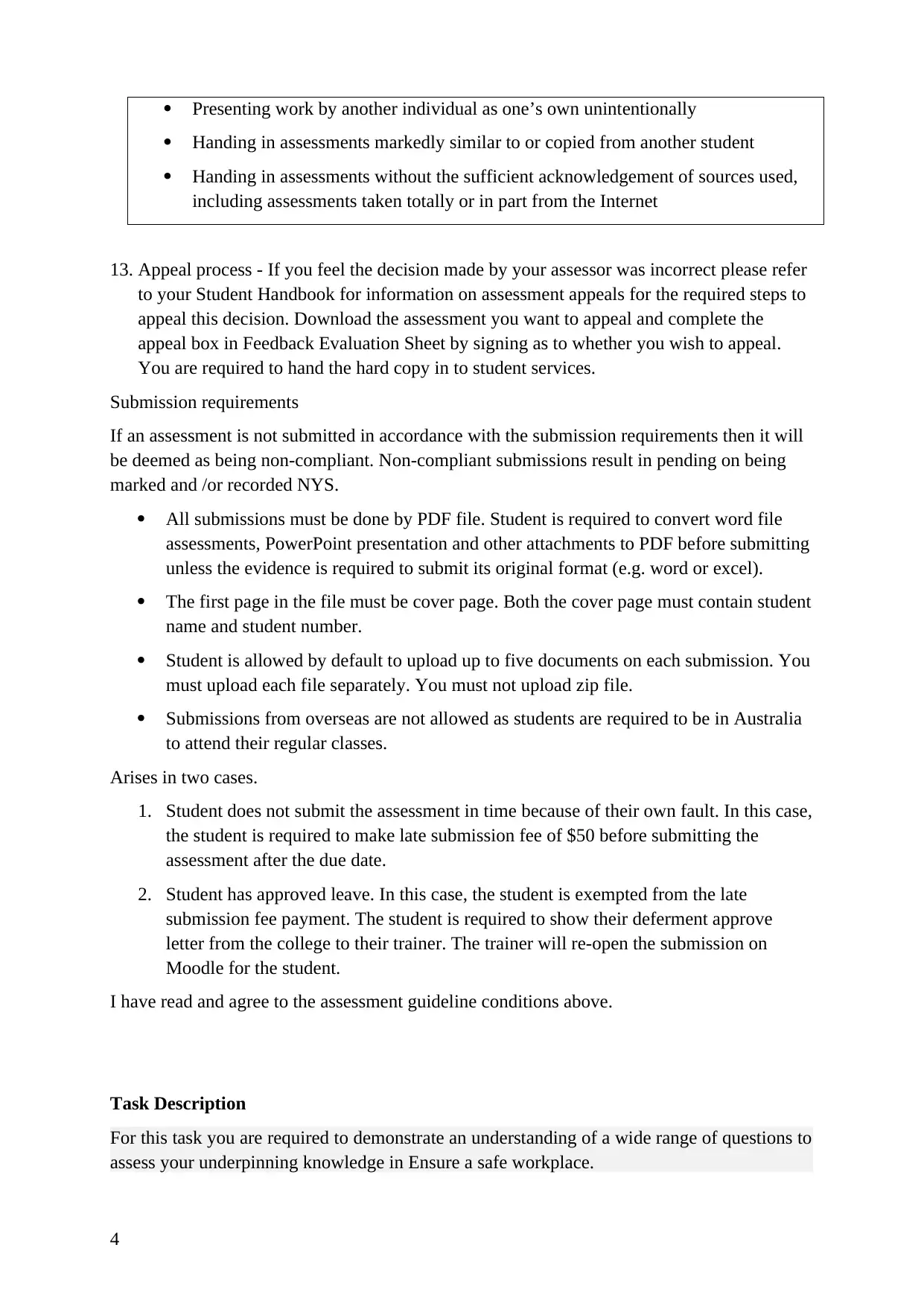
Presenting work by another individual as one’s own unintentionally
Handing in assessments markedly similar to or copied from another student
Handing in assessments without the sufficient acknowledgement of sources used,
including assessments taken totally or in part from the Internet
13. Appeal process - If you feel the decision made by your assessor was incorrect please refer
to your Student Handbook for information on assessment appeals for the required steps to
appeal this decision. Download the assessment you want to appeal and complete the
appeal box in Feedback Evaluation Sheet by signing as to whether you wish to appeal.
You are required to hand the hard copy in to student services.
Submission requirements
If an assessment is not submitted in accordance with the submission requirements then it will
be deemed as being non-compliant. Non-compliant submissions result in pending on being
marked and /or recorded NYS.
All submissions must be done by PDF file. Student is required to convert word file
assessments, PowerPoint presentation and other attachments to PDF before submitting
unless the evidence is required to submit its original format (e.g. word or excel).
The first page in the file must be cover page. Both the cover page must contain student
name and student number.
Student is allowed by default to upload up to five documents on each submission. You
must upload each file separately. You must not upload zip file.
Submissions from overseas are not allowed as students are required to be in Australia
to attend their regular classes.
Arises in two cases.
1. Student does not submit the assessment in time because of their own fault. In this case,
the student is required to make late submission fee of $50 before submitting the
assessment after the due date.
2. Student has approved leave. In this case, the student is exempted from the late
submission fee payment. The student is required to show their deferment approve
letter from the college to their trainer. The trainer will re-open the submission on
Moodle for the student.
I have read and agree to the assessment guideline conditions above.
Task Description
For this task you are required to demonstrate an understanding of a wide range of questions to
assess your underpinning knowledge in Ensure a safe workplace.
4
Handing in assessments markedly similar to or copied from another student
Handing in assessments without the sufficient acknowledgement of sources used,
including assessments taken totally or in part from the Internet
13. Appeal process - If you feel the decision made by your assessor was incorrect please refer
to your Student Handbook for information on assessment appeals for the required steps to
appeal this decision. Download the assessment you want to appeal and complete the
appeal box in Feedback Evaluation Sheet by signing as to whether you wish to appeal.
You are required to hand the hard copy in to student services.
Submission requirements
If an assessment is not submitted in accordance with the submission requirements then it will
be deemed as being non-compliant. Non-compliant submissions result in pending on being
marked and /or recorded NYS.
All submissions must be done by PDF file. Student is required to convert word file
assessments, PowerPoint presentation and other attachments to PDF before submitting
unless the evidence is required to submit its original format (e.g. word or excel).
The first page in the file must be cover page. Both the cover page must contain student
name and student number.
Student is allowed by default to upload up to five documents on each submission. You
must upload each file separately. You must not upload zip file.
Submissions from overseas are not allowed as students are required to be in Australia
to attend their regular classes.
Arises in two cases.
1. Student does not submit the assessment in time because of their own fault. In this case,
the student is required to make late submission fee of $50 before submitting the
assessment after the due date.
2. Student has approved leave. In this case, the student is exempted from the late
submission fee payment. The student is required to show their deferment approve
letter from the college to their trainer. The trainer will re-open the submission on
Moodle for the student.
I have read and agree to the assessment guideline conditions above.
Task Description
For this task you are required to demonstrate an understanding of a wide range of questions to
assess your underpinning knowledge in Ensure a safe workplace.
4
Paraphrase This Document
Need a fresh take? Get an instant paraphrase of this document with our AI Paraphraser
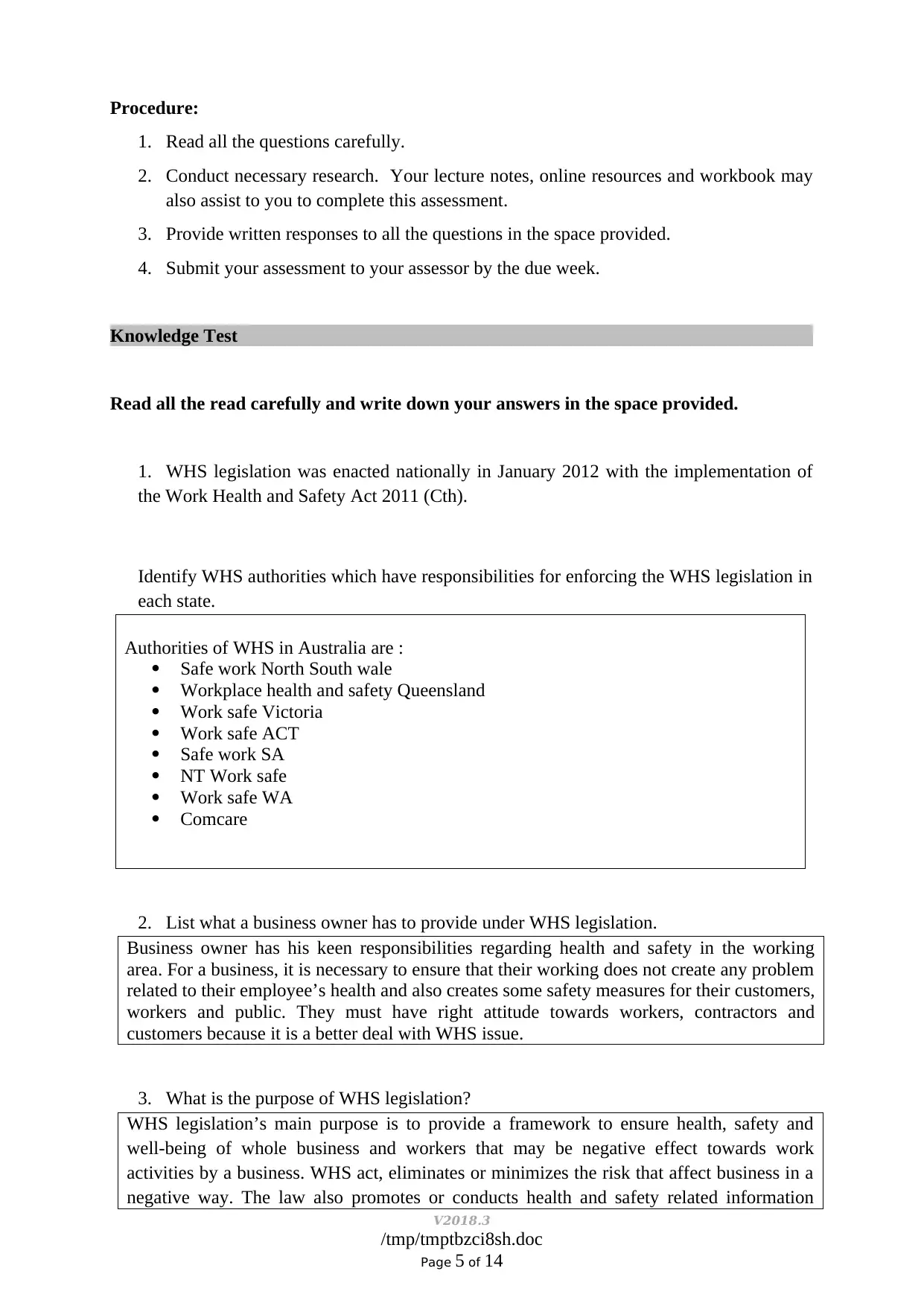
Procedure:
1. Read all the questions carefully.
2. Conduct necessary research. Your lecture notes, online resources and workbook may
also assist to you to complete this assessment.
3. Provide written responses to all the questions in the space provided.
4. Submit your assessment to your assessor by the due week.
Knowledge Test
Read all the read carefully and write down your answers in the space provided.
1. WHS legislation was enacted nationally in January 2012 with the implementation of
the Work Health and Safety Act 2011 (Cth).
Identify WHS authorities which have responsibilities for enforcing the WHS legislation in
each state.
Authorities of WHS in Australia are :
Safe work North South wale
Workplace health and safety Queensland
Work safe Victoria
Work safe ACT
Safe work SA
NT Work safe
Work safe WA
Comcare
2. List what a business owner has to provide under WHS legislation.
Business owner has his keen responsibilities regarding health and safety in the working
area. For a business, it is necessary to ensure that their working does not create any problem
related to their employee’s health and also creates some safety measures for their customers,
workers and public. They must have right attitude towards workers, contractors and
customers because it is a better deal with WHS issue.
3. What is the purpose of WHS legislation?
WHS legislation’s main purpose is to provide a framework to ensure health, safety and
well-being of whole business and workers that may be negative effect towards work
activities by a business. WHS act, eliminates or minimizes the risk that affect business in a
negative way. The law also promotes or conducts health and safety related information
V2018.3
/tmp/tmptbzci8sh.doc
Page 5 of 14
1. Read all the questions carefully.
2. Conduct necessary research. Your lecture notes, online resources and workbook may
also assist to you to complete this assessment.
3. Provide written responses to all the questions in the space provided.
4. Submit your assessment to your assessor by the due week.
Knowledge Test
Read all the read carefully and write down your answers in the space provided.
1. WHS legislation was enacted nationally in January 2012 with the implementation of
the Work Health and Safety Act 2011 (Cth).
Identify WHS authorities which have responsibilities for enforcing the WHS legislation in
each state.
Authorities of WHS in Australia are :
Safe work North South wale
Workplace health and safety Queensland
Work safe Victoria
Work safe ACT
Safe work SA
NT Work safe
Work safe WA
Comcare
2. List what a business owner has to provide under WHS legislation.
Business owner has his keen responsibilities regarding health and safety in the working
area. For a business, it is necessary to ensure that their working does not create any problem
related to their employee’s health and also creates some safety measures for their customers,
workers and public. They must have right attitude towards workers, contractors and
customers because it is a better deal with WHS issue.
3. What is the purpose of WHS legislation?
WHS legislation’s main purpose is to provide a framework to ensure health, safety and
well-being of whole business and workers that may be negative effect towards work
activities by a business. WHS act, eliminates or minimizes the risk that affect business in a
negative way. The law also promotes or conducts health and safety related information
V2018.3
/tmp/tmptbzci8sh.doc
Page 5 of 14
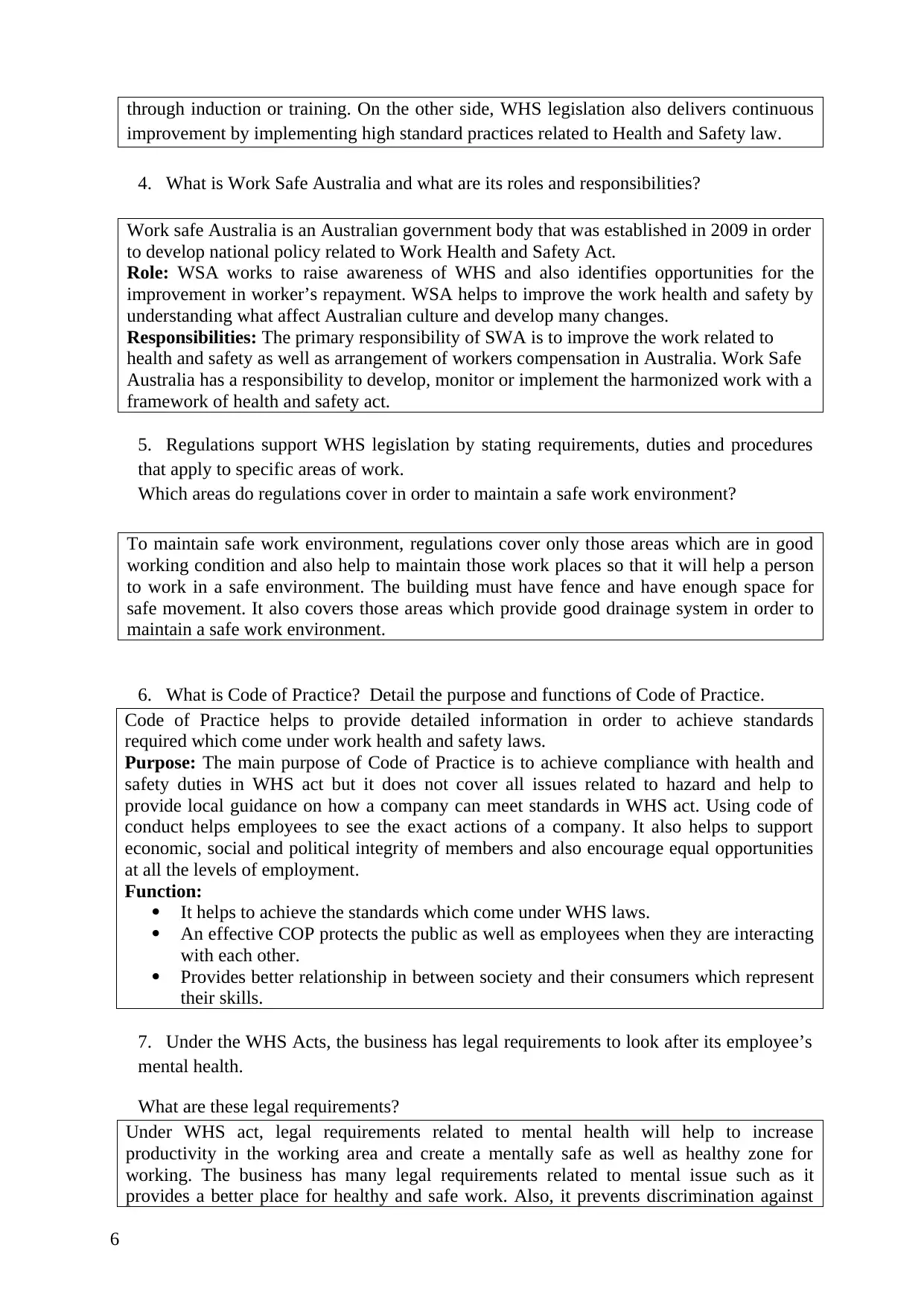
through induction or training. On the other side, WHS legislation also delivers continuous
improvement by implementing high standard practices related to Health and Safety law.
4. What is Work Safe Australia and what are its roles and responsibilities?
Work safe Australia is an Australian government body that was established in 2009 in order
to develop national policy related to Work Health and Safety Act.
Role: WSA works to raise awareness of WHS and also identifies opportunities for the
improvement in worker’s repayment. WSA helps to improve the work health and safety by
understanding what affect Australian culture and develop many changes.
Responsibilities: The primary responsibility of SWA is to improve the work related to
health and safety as well as arrangement of workers compensation in Australia. Work Safe
Australia has a responsibility to develop, monitor or implement the harmonized work with a
framework of health and safety act.
5. Regulations support WHS legislation by stating requirements, duties and procedures
that apply to specific areas of work.
Which areas do regulations cover in order to maintain a safe work environment?
To maintain safe work environment, regulations cover only those areas which are in good
working condition and also help to maintain those work places so that it will help a person
to work in a safe environment. The building must have fence and have enough space for
safe movement. It also covers those areas which provide good drainage system in order to
maintain a safe work environment.
6. What is Code of Practice? Detail the purpose and functions of Code of Practice.
Code of Practice helps to provide detailed information in order to achieve standards
required which come under work health and safety laws.
Purpose: The main purpose of Code of Practice is to achieve compliance with health and
safety duties in WHS act but it does not cover all issues related to hazard and help to
provide local guidance on how a company can meet standards in WHS act. Using code of
conduct helps employees to see the exact actions of a company. It also helps to support
economic, social and political integrity of members and also encourage equal opportunities
at all the levels of employment.
Function:
It helps to achieve the standards which come under WHS laws.
An effective COP protects the public as well as employees when they are interacting
with each other.
Provides better relationship in between society and their consumers which represent
their skills.
7. Under the WHS Acts, the business has legal requirements to look after its employee’s
mental health.
What are these legal requirements?
Under WHS act, legal requirements related to mental health will help to increase
productivity in the working area and create a mentally safe as well as healthy zone for
working. The business has many legal requirements related to mental issue such as it
provides a better place for healthy and safe work. Also, it prevents discrimination against
6
improvement by implementing high standard practices related to Health and Safety law.
4. What is Work Safe Australia and what are its roles and responsibilities?
Work safe Australia is an Australian government body that was established in 2009 in order
to develop national policy related to Work Health and Safety Act.
Role: WSA works to raise awareness of WHS and also identifies opportunities for the
improvement in worker’s repayment. WSA helps to improve the work health and safety by
understanding what affect Australian culture and develop many changes.
Responsibilities: The primary responsibility of SWA is to improve the work related to
health and safety as well as arrangement of workers compensation in Australia. Work Safe
Australia has a responsibility to develop, monitor or implement the harmonized work with a
framework of health and safety act.
5. Regulations support WHS legislation by stating requirements, duties and procedures
that apply to specific areas of work.
Which areas do regulations cover in order to maintain a safe work environment?
To maintain safe work environment, regulations cover only those areas which are in good
working condition and also help to maintain those work places so that it will help a person
to work in a safe environment. The building must have fence and have enough space for
safe movement. It also covers those areas which provide good drainage system in order to
maintain a safe work environment.
6. What is Code of Practice? Detail the purpose and functions of Code of Practice.
Code of Practice helps to provide detailed information in order to achieve standards
required which come under work health and safety laws.
Purpose: The main purpose of Code of Practice is to achieve compliance with health and
safety duties in WHS act but it does not cover all issues related to hazard and help to
provide local guidance on how a company can meet standards in WHS act. Using code of
conduct helps employees to see the exact actions of a company. It also helps to support
economic, social and political integrity of members and also encourage equal opportunities
at all the levels of employment.
Function:
It helps to achieve the standards which come under WHS laws.
An effective COP protects the public as well as employees when they are interacting
with each other.
Provides better relationship in between society and their consumers which represent
their skills.
7. Under the WHS Acts, the business has legal requirements to look after its employee’s
mental health.
What are these legal requirements?
Under WHS act, legal requirements related to mental health will help to increase
productivity in the working area and create a mentally safe as well as healthy zone for
working. The business has many legal requirements related to mental issue such as it
provides a better place for healthy and safe work. Also, it prevents discrimination against
6
⊘ This is a preview!⊘
Do you want full access?
Subscribe today to unlock all pages.

Trusted by 1+ million students worldwide
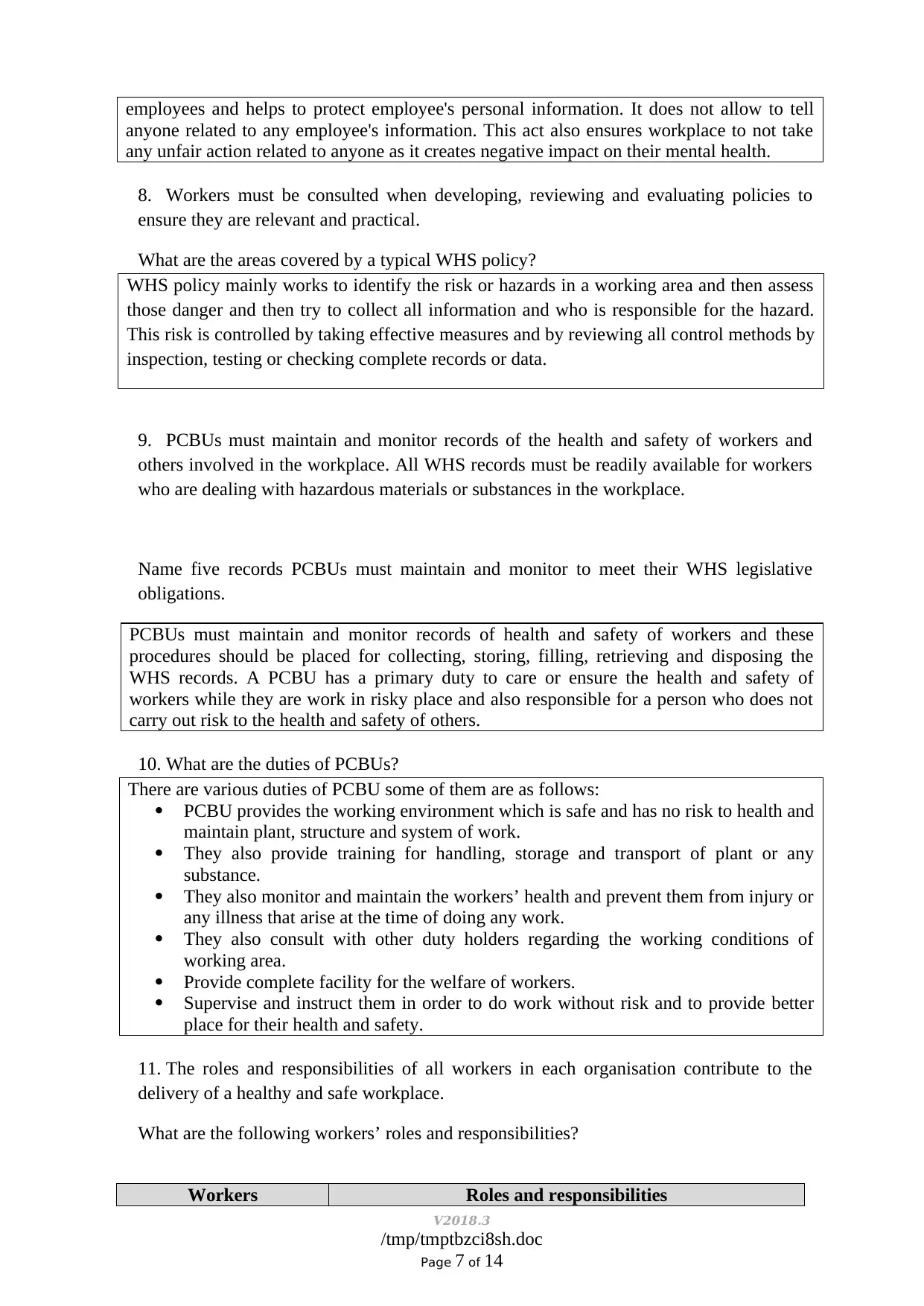
employees and helps to protect employee's personal information. It does not allow to tell
anyone related to any employee's information. This act also ensures workplace to not take
any unfair action related to anyone as it creates negative impact on their mental health.
8. Workers must be consulted when developing, reviewing and evaluating policies to
ensure they are relevant and practical.
What are the areas covered by a typical WHS policy?
WHS policy mainly works to identify the risk or hazards in a working area and then assess
those danger and then try to collect all information and who is responsible for the hazard.
This risk is controlled by taking effective measures and by reviewing all control methods by
inspection, testing or checking complete records or data.
9. PCBUs must maintain and monitor records of the health and safety of workers and
others involved in the workplace. All WHS records must be readily available for workers
who are dealing with hazardous materials or substances in the workplace.
Name five records PCBUs must maintain and monitor to meet their WHS legislative
obligations.
PCBUs must maintain and monitor records of health and safety of workers and these
procedures should be placed for collecting, storing, filling, retrieving and disposing the
WHS records. A PCBU has a primary duty to care or ensure the health and safety of
workers while they are work in risky place and also responsible for a person who does not
carry out risk to the health and safety of others.
10. What are the duties of PCBUs?
There are various duties of PCBU some of them are as follows:
PCBU provides the working environment which is safe and has no risk to health and
maintain plant, structure and system of work.
They also provide training for handling, storage and transport of plant or any
substance.
They also monitor and maintain the workers’ health and prevent them from injury or
any illness that arise at the time of doing any work.
They also consult with other duty holders regarding the working conditions of
working area.
Provide complete facility for the welfare of workers.
Supervise and instruct them in order to do work without risk and to provide better
place for their health and safety.
11. The roles and responsibilities of all workers in each organisation contribute to the
delivery of a healthy and safe workplace.
What are the following workers’ roles and responsibilities?
Workers Roles and responsibilities
V2018.3
/tmp/tmptbzci8sh.doc
Page 7 of 14
anyone related to any employee's information. This act also ensures workplace to not take
any unfair action related to anyone as it creates negative impact on their mental health.
8. Workers must be consulted when developing, reviewing and evaluating policies to
ensure they are relevant and practical.
What are the areas covered by a typical WHS policy?
WHS policy mainly works to identify the risk or hazards in a working area and then assess
those danger and then try to collect all information and who is responsible for the hazard.
This risk is controlled by taking effective measures and by reviewing all control methods by
inspection, testing or checking complete records or data.
9. PCBUs must maintain and monitor records of the health and safety of workers and
others involved in the workplace. All WHS records must be readily available for workers
who are dealing with hazardous materials or substances in the workplace.
Name five records PCBUs must maintain and monitor to meet their WHS legislative
obligations.
PCBUs must maintain and monitor records of health and safety of workers and these
procedures should be placed for collecting, storing, filling, retrieving and disposing the
WHS records. A PCBU has a primary duty to care or ensure the health and safety of
workers while they are work in risky place and also responsible for a person who does not
carry out risk to the health and safety of others.
10. What are the duties of PCBUs?
There are various duties of PCBU some of them are as follows:
PCBU provides the working environment which is safe and has no risk to health and
maintain plant, structure and system of work.
They also provide training for handling, storage and transport of plant or any
substance.
They also monitor and maintain the workers’ health and prevent them from injury or
any illness that arise at the time of doing any work.
They also consult with other duty holders regarding the working conditions of
working area.
Provide complete facility for the welfare of workers.
Supervise and instruct them in order to do work without risk and to provide better
place for their health and safety.
11. The roles and responsibilities of all workers in each organisation contribute to the
delivery of a healthy and safe workplace.
What are the following workers’ roles and responsibilities?
Workers Roles and responsibilities
V2018.3
/tmp/tmptbzci8sh.doc
Page 7 of 14
Paraphrase This Document
Need a fresh take? Get an instant paraphrase of this document with our AI Paraphraser
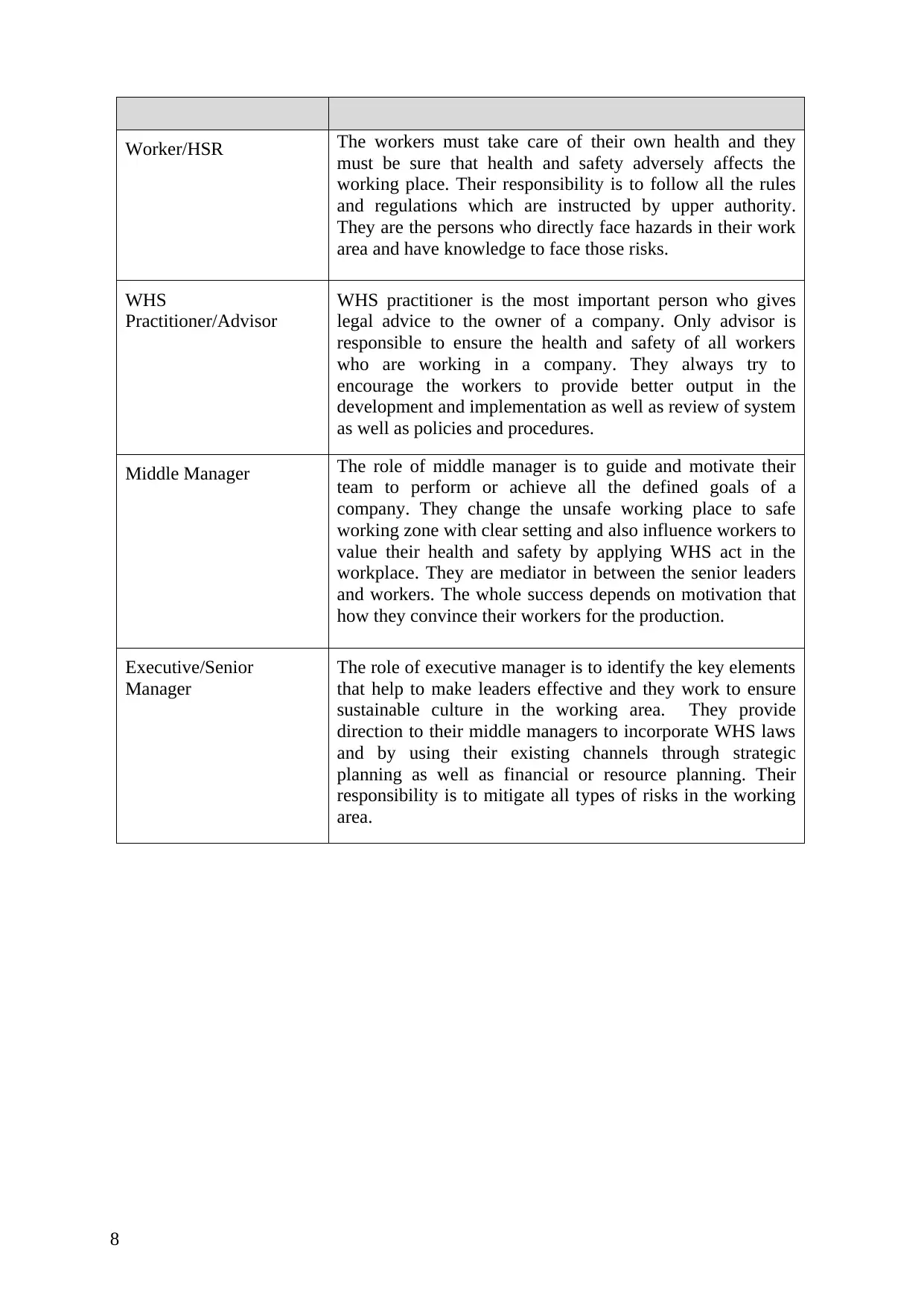
Worker/HSR The workers must take care of their own health and they
must be sure that health and safety adversely affects the
working place. Their responsibility is to follow all the rules
and regulations which are instructed by upper authority.
They are the persons who directly face hazards in their work
area and have knowledge to face those risks.
WHS
Practitioner/Advisor
WHS practitioner is the most important person who gives
legal advice to the owner of a company. Only advisor is
responsible to ensure the health and safety of all workers
who are working in a company. They always try to
encourage the workers to provide better output in the
development and implementation as well as review of system
as well as policies and procedures.
Middle Manager The role of middle manager is to guide and motivate their
team to perform or achieve all the defined goals of a
company. They change the unsafe working place to safe
working zone with clear setting and also influence workers to
value their health and safety by applying WHS act in the
workplace. They are mediator in between the senior leaders
and workers. The whole success depends on motivation that
how they convince their workers for the production.
Executive/Senior
Manager
The role of executive manager is to identify the key elements
that help to make leaders effective and they work to ensure
sustainable culture in the working area. They provide
direction to their middle managers to incorporate WHS laws
and by using their existing channels through strategic
planning as well as financial or resource planning. Their
responsibility is to mitigate all types of risks in the working
area.
8
must be sure that health and safety adversely affects the
working place. Their responsibility is to follow all the rules
and regulations which are instructed by upper authority.
They are the persons who directly face hazards in their work
area and have knowledge to face those risks.
WHS
Practitioner/Advisor
WHS practitioner is the most important person who gives
legal advice to the owner of a company. Only advisor is
responsible to ensure the health and safety of all workers
who are working in a company. They always try to
encourage the workers to provide better output in the
development and implementation as well as review of system
as well as policies and procedures.
Middle Manager The role of middle manager is to guide and motivate their
team to perform or achieve all the defined goals of a
company. They change the unsafe working place to safe
working zone with clear setting and also influence workers to
value their health and safety by applying WHS act in the
workplace. They are mediator in between the senior leaders
and workers. The whole success depends on motivation that
how they convince their workers for the production.
Executive/Senior
Manager
The role of executive manager is to identify the key elements
that help to make leaders effective and they work to ensure
sustainable culture in the working area. They provide
direction to their middle managers to incorporate WHS laws
and by using their existing channels through strategic
planning as well as financial or resource planning. Their
responsibility is to mitigate all types of risks in the working
area.
8
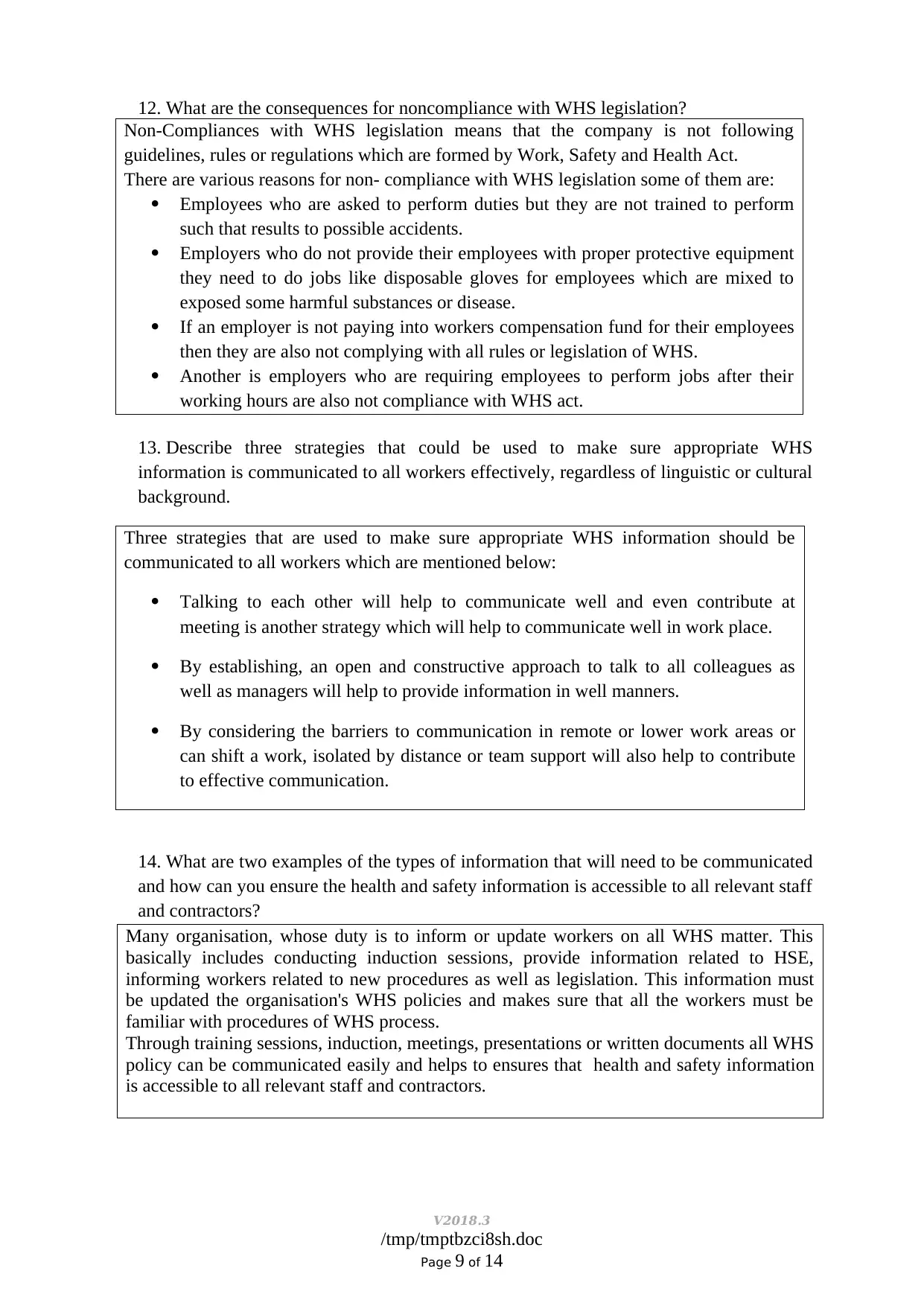
12. What are the consequences for noncompliance with WHS legislation?
Non-Compliances with WHS legislation means that the company is not following
guidelines, rules or regulations which are formed by Work, Safety and Health Act.
There are various reasons for non- compliance with WHS legislation some of them are:
Employees who are asked to perform duties but they are not trained to perform
such that results to possible accidents.
Employers who do not provide their employees with proper protective equipment
they need to do jobs like disposable gloves for employees which are mixed to
exposed some harmful substances or disease.
If an employer is not paying into workers compensation fund for their employees
then they are also not complying with all rules or legislation of WHS.
Another is employers who are requiring employees to perform jobs after their
working hours are also not compliance with WHS act.
13. Describe three strategies that could be used to make sure appropriate WHS
information is communicated to all workers effectively, regardless of linguistic or cultural
background.
Three strategies that are used to make sure appropriate WHS information should be
communicated to all workers which are mentioned below:
Talking to each other will help to communicate well and even contribute at
meeting is another strategy which will help to communicate well in work place.
By establishing, an open and constructive approach to talk to all colleagues as
well as managers will help to provide information in well manners.
By considering the barriers to communication in remote or lower work areas or
can shift a work, isolated by distance or team support will also help to contribute
to effective communication.
14. What are two examples of the types of information that will need to be communicated
and how can you ensure the health and safety information is accessible to all relevant staff
and contractors?
Many organisation, whose duty is to inform or update workers on all WHS matter. This
basically includes conducting induction sessions, provide information related to HSE,
informing workers related to new procedures as well as legislation. This information must
be updated the organisation's WHS policies and makes sure that all the workers must be
familiar with procedures of WHS process.
Through training sessions, induction, meetings, presentations or written documents all WHS
policy can be communicated easily and helps to ensures that health and safety information
is accessible to all relevant staff and contractors.
V2018.3
/tmp/tmptbzci8sh.doc
Page 9 of 14
Non-Compliances with WHS legislation means that the company is not following
guidelines, rules or regulations which are formed by Work, Safety and Health Act.
There are various reasons for non- compliance with WHS legislation some of them are:
Employees who are asked to perform duties but they are not trained to perform
such that results to possible accidents.
Employers who do not provide their employees with proper protective equipment
they need to do jobs like disposable gloves for employees which are mixed to
exposed some harmful substances or disease.
If an employer is not paying into workers compensation fund for their employees
then they are also not complying with all rules or legislation of WHS.
Another is employers who are requiring employees to perform jobs after their
working hours are also not compliance with WHS act.
13. Describe three strategies that could be used to make sure appropriate WHS
information is communicated to all workers effectively, regardless of linguistic or cultural
background.
Three strategies that are used to make sure appropriate WHS information should be
communicated to all workers which are mentioned below:
Talking to each other will help to communicate well and even contribute at
meeting is another strategy which will help to communicate well in work place.
By establishing, an open and constructive approach to talk to all colleagues as
well as managers will help to provide information in well manners.
By considering the barriers to communication in remote or lower work areas or
can shift a work, isolated by distance or team support will also help to contribute
to effective communication.
14. What are two examples of the types of information that will need to be communicated
and how can you ensure the health and safety information is accessible to all relevant staff
and contractors?
Many organisation, whose duty is to inform or update workers on all WHS matter. This
basically includes conducting induction sessions, provide information related to HSE,
informing workers related to new procedures as well as legislation. This information must
be updated the organisation's WHS policies and makes sure that all the workers must be
familiar with procedures of WHS process.
Through training sessions, induction, meetings, presentations or written documents all WHS
policy can be communicated easily and helps to ensures that health and safety information
is accessible to all relevant staff and contractors.
V2018.3
/tmp/tmptbzci8sh.doc
Page 9 of 14
⊘ This is a preview!⊘
Do you want full access?
Subscribe today to unlock all pages.

Trusted by 1+ million students worldwide
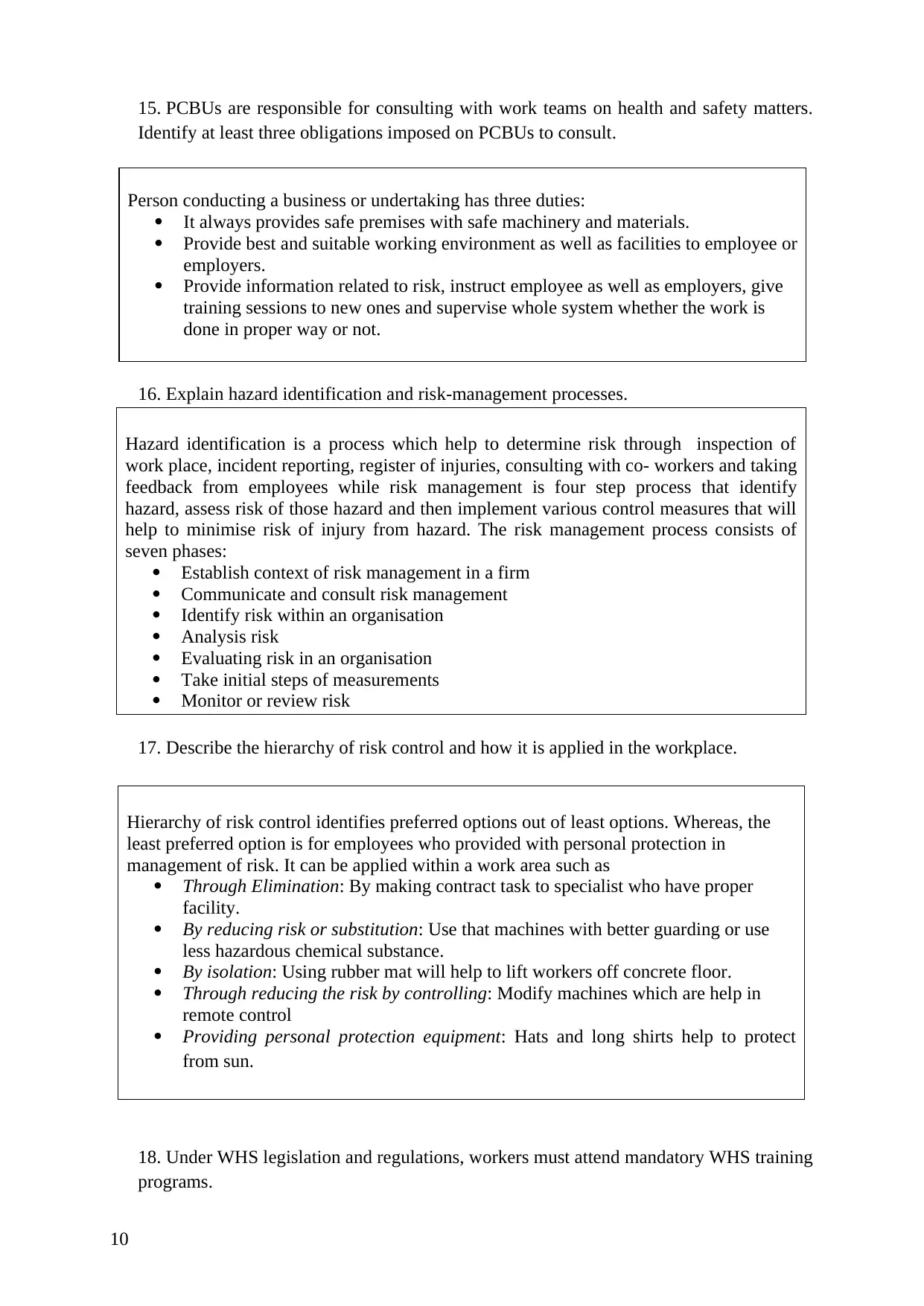
15. PCBUs are responsible for consulting with work teams on health and safety matters.
Identify at least three obligations imposed on PCBUs to consult.
Person conducting a business or undertaking has three duties:
It always provides safe premises with safe machinery and materials.
Provide best and suitable working environment as well as facilities to employee or
employers.
Provide information related to risk, instruct employee as well as employers, give
training sessions to new ones and supervise whole system whether the work is
done in proper way or not.
16. Explain hazard identification and risk-management processes.
Hazard identification is a process which help to determine risk through inspection of
work place, incident reporting, register of injuries, consulting with co- workers and taking
feedback from employees while risk management is four step process that identify
hazard, assess risk of those hazard and then implement various control measures that will
help to minimise risk of injury from hazard. The risk management process consists of
seven phases:
Establish context of risk management in a firm
Communicate and consult risk management
Identify risk within an organisation
Analysis risk
Evaluating risk in an organisation
Take initial steps of measurements
Monitor or review risk
17. Describe the hierarchy of risk control and how it is applied in the workplace.
Hierarchy of risk control identifies preferred options out of least options. Whereas, the
least preferred option is for employees who provided with personal protection in
management of risk. It can be applied within a work area such as
Through Elimination: By making contract task to specialist who have proper
facility.
By reducing risk or substitution: Use that machines with better guarding or use
less hazardous chemical substance.
By isolation: Using rubber mat will help to lift workers off concrete floor.
Through reducing the risk by controlling: Modify machines which are help in
remote control
Providing personal protection equipment: Hats and long shirts help to protect
from sun.
18. Under WHS legislation and regulations, workers must attend mandatory WHS training
programs.
10
Identify at least three obligations imposed on PCBUs to consult.
Person conducting a business or undertaking has three duties:
It always provides safe premises with safe machinery and materials.
Provide best and suitable working environment as well as facilities to employee or
employers.
Provide information related to risk, instruct employee as well as employers, give
training sessions to new ones and supervise whole system whether the work is
done in proper way or not.
16. Explain hazard identification and risk-management processes.
Hazard identification is a process which help to determine risk through inspection of
work place, incident reporting, register of injuries, consulting with co- workers and taking
feedback from employees while risk management is four step process that identify
hazard, assess risk of those hazard and then implement various control measures that will
help to minimise risk of injury from hazard. The risk management process consists of
seven phases:
Establish context of risk management in a firm
Communicate and consult risk management
Identify risk within an organisation
Analysis risk
Evaluating risk in an organisation
Take initial steps of measurements
Monitor or review risk
17. Describe the hierarchy of risk control and how it is applied in the workplace.
Hierarchy of risk control identifies preferred options out of least options. Whereas, the
least preferred option is for employees who provided with personal protection in
management of risk. It can be applied within a work area such as
Through Elimination: By making contract task to specialist who have proper
facility.
By reducing risk or substitution: Use that machines with better guarding or use
less hazardous chemical substance.
By isolation: Using rubber mat will help to lift workers off concrete floor.
Through reducing the risk by controlling: Modify machines which are help in
remote control
Providing personal protection equipment: Hats and long shirts help to protect
from sun.
18. Under WHS legislation and regulations, workers must attend mandatory WHS training
programs.
10
Paraphrase This Document
Need a fresh take? Get an instant paraphrase of this document with our AI Paraphraser
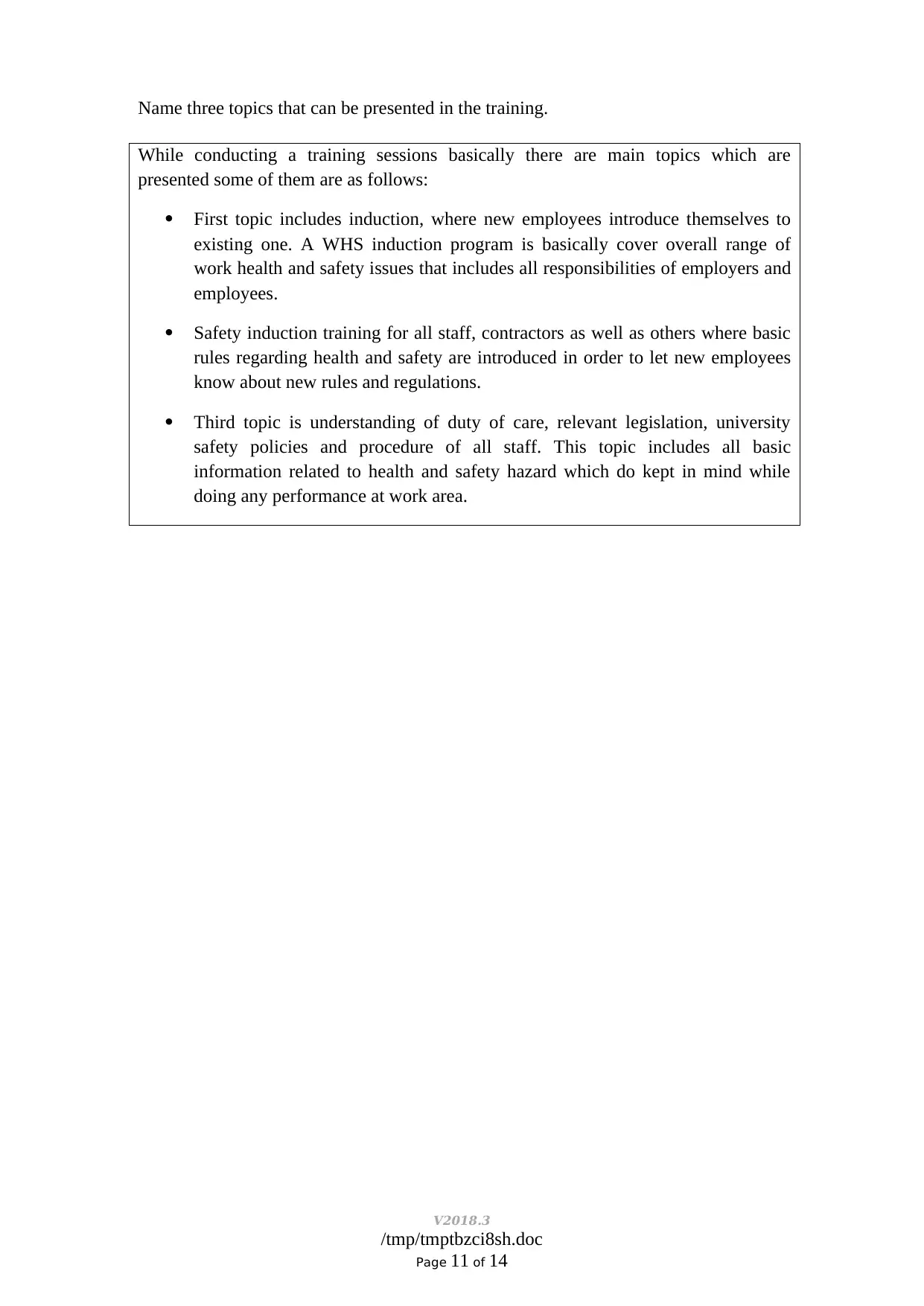
Name three topics that can be presented in the training.
While conducting a training sessions basically there are main topics which are
presented some of them are as follows:
First topic includes induction, where new employees introduce themselves to
existing one. A WHS induction program is basically cover overall range of
work health and safety issues that includes all responsibilities of employers and
employees.
Safety induction training for all staff, contractors as well as others where basic
rules regarding health and safety are introduced in order to let new employees
know about new rules and regulations.
Third topic is understanding of duty of care, relevant legislation, university
safety policies and procedure of all staff. This topic includes all basic
information related to health and safety hazard which do kept in mind while
doing any performance at work area.
V2018.3
/tmp/tmptbzci8sh.doc
Page 11 of 14
While conducting a training sessions basically there are main topics which are
presented some of them are as follows:
First topic includes induction, where new employees introduce themselves to
existing one. A WHS induction program is basically cover overall range of
work health and safety issues that includes all responsibilities of employers and
employees.
Safety induction training for all staff, contractors as well as others where basic
rules regarding health and safety are introduced in order to let new employees
know about new rules and regulations.
Third topic is understanding of duty of care, relevant legislation, university
safety policies and procedure of all staff. This topic includes all basic
information related to health and safety hazard which do kept in mind while
doing any performance at work area.
V2018.3
/tmp/tmptbzci8sh.doc
Page 11 of 14
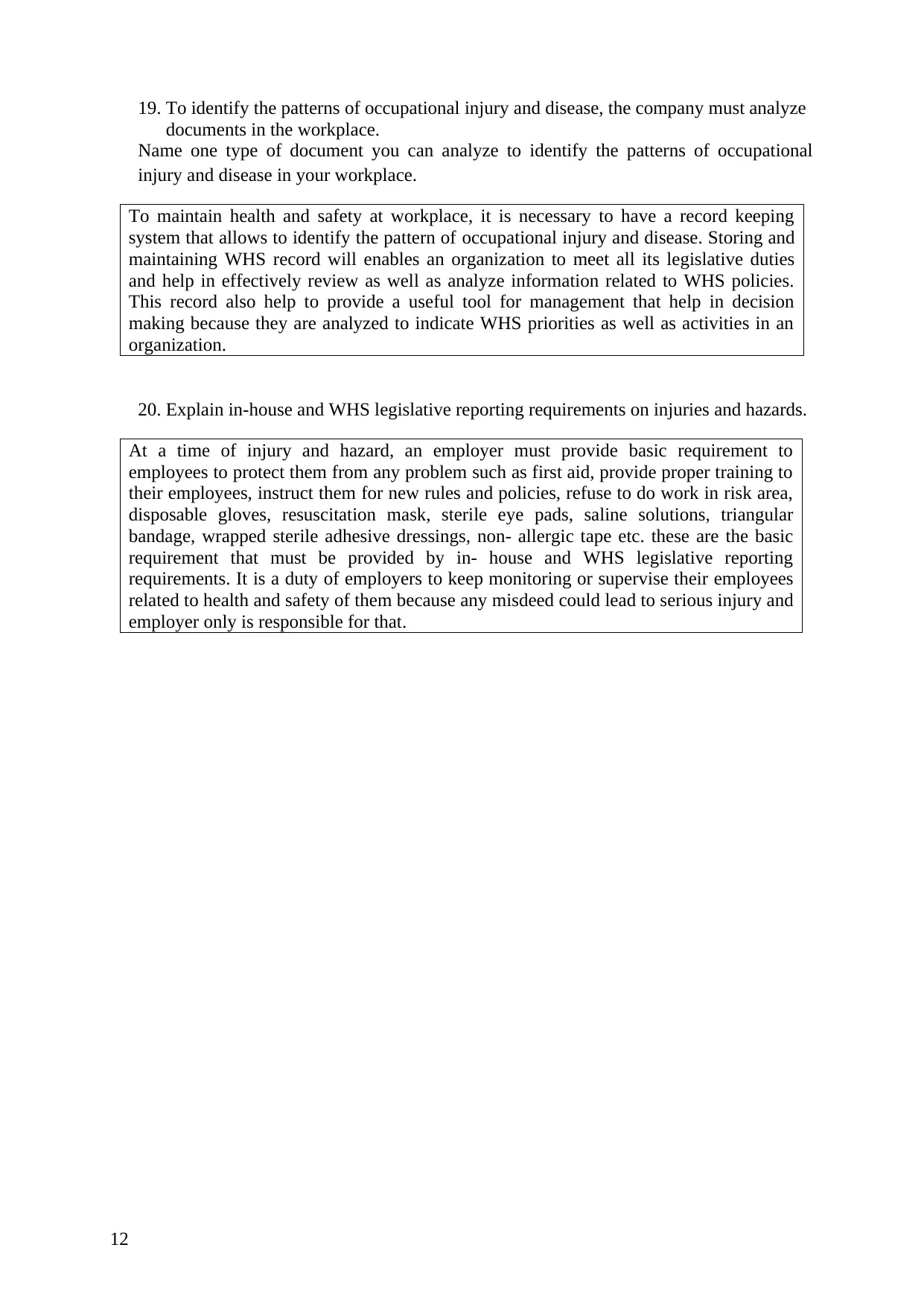
19. To identify the patterns of occupational injury and disease, the company must analyze
documents in the workplace.
Name one type of document you can analyze to identify the patterns of occupational
injury and disease in your workplace.
To maintain health and safety at workplace, it is necessary to have a record keeping
system that allows to identify the pattern of occupational injury and disease. Storing and
maintaining WHS record will enables an organization to meet all its legislative duties
and help in effectively review as well as analyze information related to WHS policies.
This record also help to provide a useful tool for management that help in decision
making because they are analyzed to indicate WHS priorities as well as activities in an
organization.
20. Explain in-house and WHS legislative reporting requirements on injuries and hazards.
At a time of injury and hazard, an employer must provide basic requirement to
employees to protect them from any problem such as first aid, provide proper training to
their employees, instruct them for new rules and policies, refuse to do work in risk area,
disposable gloves, resuscitation mask, sterile eye pads, saline solutions, triangular
bandage, wrapped sterile adhesive dressings, non- allergic tape etc. these are the basic
requirement that must be provided by in- house and WHS legislative reporting
requirements. It is a duty of employers to keep monitoring or supervise their employees
related to health and safety of them because any misdeed could lead to serious injury and
employer only is responsible for that.
12
documents in the workplace.
Name one type of document you can analyze to identify the patterns of occupational
injury and disease in your workplace.
To maintain health and safety at workplace, it is necessary to have a record keeping
system that allows to identify the pattern of occupational injury and disease. Storing and
maintaining WHS record will enables an organization to meet all its legislative duties
and help in effectively review as well as analyze information related to WHS policies.
This record also help to provide a useful tool for management that help in decision
making because they are analyzed to indicate WHS priorities as well as activities in an
organization.
20. Explain in-house and WHS legislative reporting requirements on injuries and hazards.
At a time of injury and hazard, an employer must provide basic requirement to
employees to protect them from any problem such as first aid, provide proper training to
their employees, instruct them for new rules and policies, refuse to do work in risk area,
disposable gloves, resuscitation mask, sterile eye pads, saline solutions, triangular
bandage, wrapped sterile adhesive dressings, non- allergic tape etc. these are the basic
requirement that must be provided by in- house and WHS legislative reporting
requirements. It is a duty of employers to keep monitoring or supervise their employees
related to health and safety of them because any misdeed could lead to serious injury and
employer only is responsible for that.
12
⊘ This is a preview!⊘
Do you want full access?
Subscribe today to unlock all pages.

Trusted by 1+ million students worldwide
1 out of 14
Related Documents
Your All-in-One AI-Powered Toolkit for Academic Success.
+13062052269
info@desklib.com
Available 24*7 on WhatsApp / Email
![[object Object]](/_next/static/media/star-bottom.7253800d.svg)
Unlock your academic potential
Copyright © 2020–2025 A2Z Services. All Rights Reserved. Developed and managed by ZUCOL.





